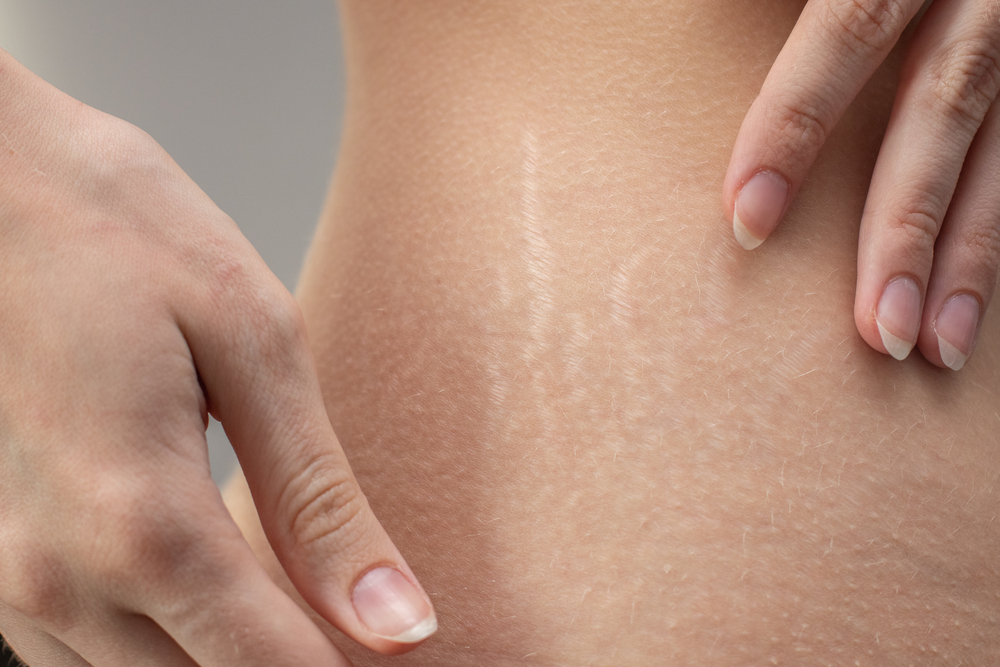
Cream can help avoid stretch marks
Stretch marks are known as striae gravidarum or striae distensae . They look like indented streaks in your skin and may be silver, purple, or red in appearance. Stretch marks most often appear on the stomach, chest, hips, bottom and thighs.
A stretch mark is a type of scar that starts developing when our skin stretches or shrinks very rapidly. This sudden stretching and shrinking cause the collagen and elastin, which support our skin, to rupture. As the skin heals from this change, these appear as stretch marks.
Not everyone develops these on their skin. Fluctuating hormone levels may also play a role in the appearance of these scars. If the people in your family have stretch marks more commonly you may have a higher risk of developing them as well. If your mom, dad, grandparents, or other blood relative has stretch marks, you’re more prone to get them.
Who can get stretch marks?
These are the moments when you're most likely to get the stretch marks on your body:
- Growth spurts during puberty
- Pregnancy
- Rapid weight loss or gain
- Weight training is when you have rapid muscle growth
When stretch marks start appearing, at first depending on your skin colour, they tend to be red, purple, pink, reddish-brown, or dark brown. Early stretch marks may be slightly raised and itchy.
Eventually, the colour fades and the narrow bands sink beneath the skin. If you run your hand over a mature stretch mark, you often feel a slight depression.
stretch marks can emerge at any age, although they are more common during pregnancy.
If your stretch marks are relatively fresh, over-the-counter lotions may be helpful in fading them.
However, if you've had stretch marks for a while, getting rid of them can be a little more challenging.
How do I reduce stretch marks?
Although there are no foolproof methods to avoid stretch marks, there are a few precautions one can take, such as:
- Hydration: Drinking plenty of water will help keep your skin hydrated and soft, which will reduce the likelihood of developing stretch marks. Avoid consuming high amounts of caffeine, as it can cause dehydration and increase your risk of developing stretch marks. Therefore, it is a good idea to balance out the consumption of coffee, tea, or soda pop by drinking more water.
- Diet: Food plays an important role in skin health. Incorporate nutrient-rich foods that are required for collagen growth and benefit your skin, such as nuts or fish, which are rich in zinc, carrots, citrus fruits, and milk, which is rich in vitamins A, C, and D.
Foods rich in protein, such as lentils, beans, broccoli, lean beef, and chicken, are also essential.
- Exercise: Exercise boosts blood circulation, which in turn favours your body’s production of collagen. Increased blood circulation and higher production of collagen keep your skin strong and stretchy, thus helping prevent stretch marks.
Conclusion:
Stretch marks often fade to become less noticeable with time. They could be challenging to avoid, and there are currently no clinically proven solutions. Many lotions, oils, and other personal care products claim to help prevent stretch marks, however, many of these claims are not substantiated by scientific evidence. In most situations, they won't help but they won't hurt either. Keeping a healthy weight, drinking plenty of water, eating a balanced diet, and receiving therapy as soon as the markings appear may all be beneficial. Contact your doctor if you notice more stretch marks or if these cover a sizable portion of your body. Your doctor might be able to pinpoint the reason for your symptoms and offer various forms of therapy. Stretch mark cream is not the miraculous solution that some believe it to be. If you're searching for a low-risk, low-cost prospective answer, it's worth a shot, but don't be surprised if they don't provide the desired outcomes.






